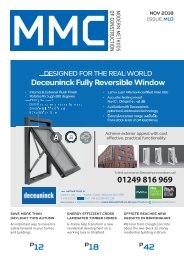Create successful ePaper yourself
Turn your PDF publications into a flip-book with our unique Google optimized e-Paper software.
commonly requires the design to be tied down at<br />
a much earlier stage, reducing flexibility, and<br />
suppliers to be paid much earlier in the cash<br />
flow.<br />
The focus is still on what is being built and, as<br />
such, the same approach - using traditional<br />
construction methods - becomes the default<br />
position.<br />
As a general rule it matters not which annual or<br />
sustainability report you choose to read, there is<br />
plenty of narrative highlighting where major<br />
contractors have been active and what they have<br />
been building.<br />
We frequently see information about the<br />
projects completed, linking schemes to health<br />
and safety targets, financial results,<br />
environmental results and achievements, but<br />
very little information on how such projects<br />
were built, the methods of construction and how<br />
these have helped contribute to targets.<br />
If this focus were to change, then I believe we<br />
could see a considerable change in the methods<br />
of construction being used.<br />
Investing for growth<br />
Major contractors still have a fantastic<br />
opportunity to make major gains in productivity<br />
by investing for growth through the development<br />
and implementation of offsite techniques into<br />
their business and site operations. The gains<br />
made by the automotive sector are something<br />
that could be replicated by the UK’s major<br />
contractors but it will take vision, leadership and<br />
change to drive a revolution in terms of how we<br />
deliver projects.<br />
To hit the ambitious targets in construction, the<br />
pace of investment in offsite manufacture will<br />
need to significantly increase. Also, the way in<br />
which offsite is incorporated into construction<br />
methodologies on site will also need to be<br />
revisited in order to make sure that the<br />
maximum time and efficiency savings are<br />
secured.<br />
Moving from site to factory<br />
Construction sites by their very nature feature<br />
many unknowns. By shifting many elements of<br />
the build to offsite manufacture, we are able to<br />
produce many of the projects build components<br />
under strict factory conditions. As a result of<br />
this, the quality of the build improves as each<br />
stage of production is closely monitored. By<br />
moving the bulk of the work to a factory, less<br />
operatives will be required on site and their role<br />
will mainly cover installation and assembly so<br />
productivity improves. There are also major<br />
health and safety benefits from moving the bulk<br />
of the difficult work to factory conditions.<br />
ROI – proving the value<br />
At Birmingham New Street Station our modular<br />
service ‘spine’ was built offsite then installed in<br />
just 15 days, saving over 10,000 working hours<br />
and reducing carbon emissions by 57%.<br />
This is just one of many great examples where<br />
offsite manufacture has saved time, improved<br />
quality and led to better health and safety<br />
performance. As an industry, we should be<br />
sharing what we are doing and making sure that<br />
we measure and demonstrate the tangible<br />
results that can be achieved through the use of<br />
offsite manufacturing. There is a major<br />
education process needed so that the industry<br />
as a whole is aware of what can be achieved<br />
with a little forward planning and knowledge of<br />
what really is possible.<br />
The future<br />
As the UK construction market becomes<br />
increasingly global, international competitors<br />
who focus on the ‘how’ are becoming the norm.<br />
There are many new contractors entering the<br />
market that aren’t ingrained in the traditional<br />
approach to construction. Many of these new<br />
entrants are from the Far East and are bringing<br />
a wealth of new approaches to construction<br />
delivery. They are approaching the ‘how’ with a<br />
factory mentality and focusing on how to bring<br />
benefits across the entire construction process.<br />
For example, earlier this year in China, a 57-<br />
storey skyscraper was completed in three<br />
weeks by taking advantage of the reduced<br />
construction times made possible by offsite<br />
building techniques.<br />
Offsite manufacturing offers contractors a great<br />
opportunity to do more for less. Going forward,<br />
the most su<strong>cc</strong>essful contractors will be those<br />
that embrace offsite as the norm and develop a<br />
strategy that embeds offsite into all aspects of<br />
their everyday operations.<br />
There are wealth of solutions and approaches to<br />
offsite manufacture and the key for UK<br />
contractors will be to not only keep up to date<br />
with the latest innovations but more importantly<br />
to understand how these innovations can drive<br />
their business strategy and their methodologies<br />
on site to boost productivity.<br />
I am very lucky in the fact that the company I<br />
work for has invested heavily in its offsite<br />
capabilities over the last 16 years and, while we<br />
have admittedly learnt lessons along the way,<br />
that investment and focus on the role offsite<br />
plays in projects is now becoming an<br />
increasingly dominant factor in the way we<br />
approach and more importantly ‘win’ contracts.<br />
www.ngbailey.com<br />
<strong>MMC</strong><br />
Sep/Oct 2016 <strong>M1</strong> 35

















